Great Tasting Champagne: A Guide To The Best Champagne Brands
When you think of Champagne, it’s hard not to picture celebrations, luxury, and that satisfying pop of the cork. But, if you’re like us, a true wine and food enthusiasts, Champagne is more than just
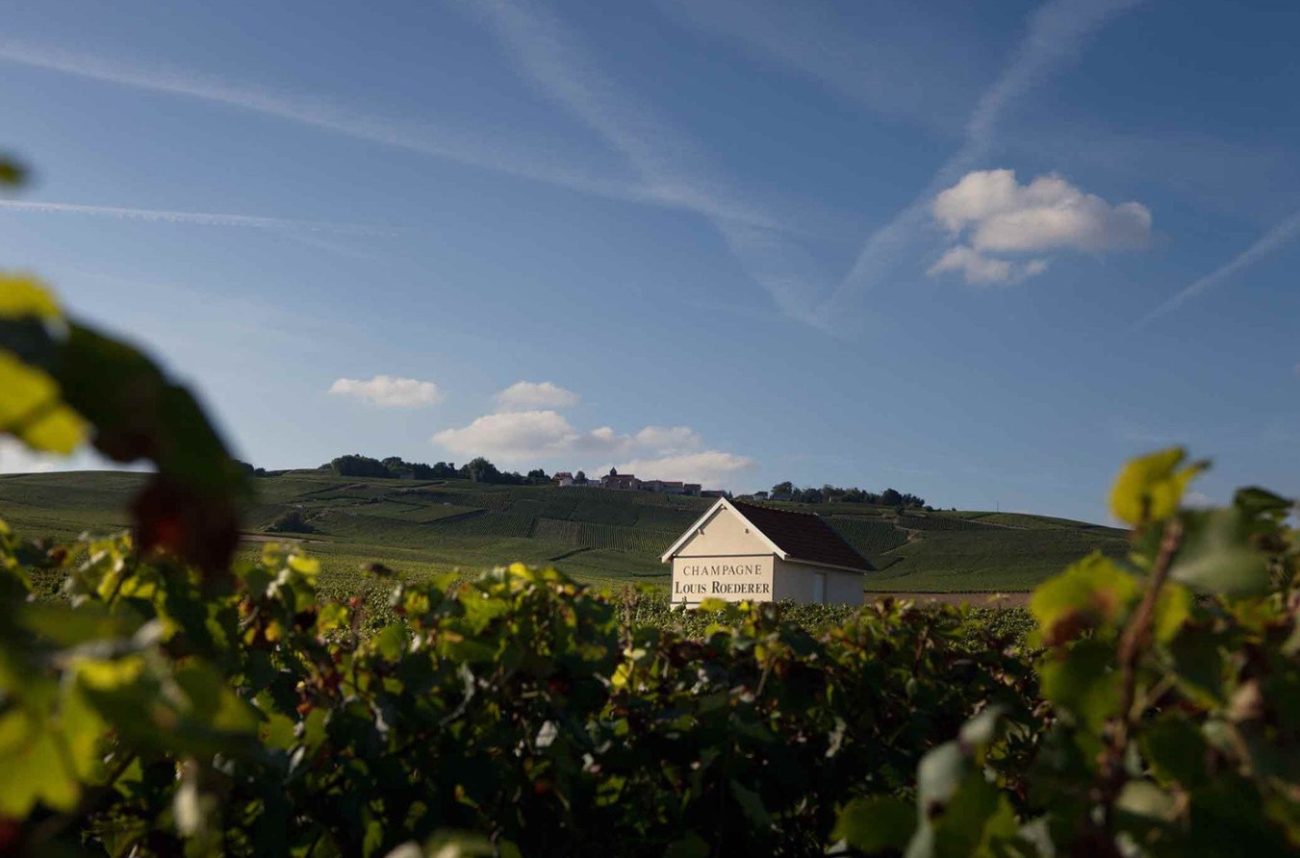
When you think of Champagne, it’s hard not to picture celebrations, luxury, and that satisfying pop of the cork. But, if you’re like us, a true wine and food enthusiasts, Champagne is more than just a celebratory drink – it’s a region, a tradition, a craft, and a journey into French winemaking tradition.
Whether you’re celebrating a milestone, ringing in a New Year, or simply indulging in something special on a quiet evening, Champagne has a unique way of elevating any moment. In this guide, we will explore some of the best Champagne brands available. PS. We will also share a few of our personal recommendations for every occasion.
Best Champagne Brands
When it comes to choosing a bottle or having the best champagne tasting, the Champagne House or producer you select can make a big difference. Many of the most famous houses and Champagne brands have been producing sparkling wines for centuries and have perfected their craft, while smaller producers are also making a name for themselves with artisanal, high-quality offerings. Here are a few key names to know.
Ruinart
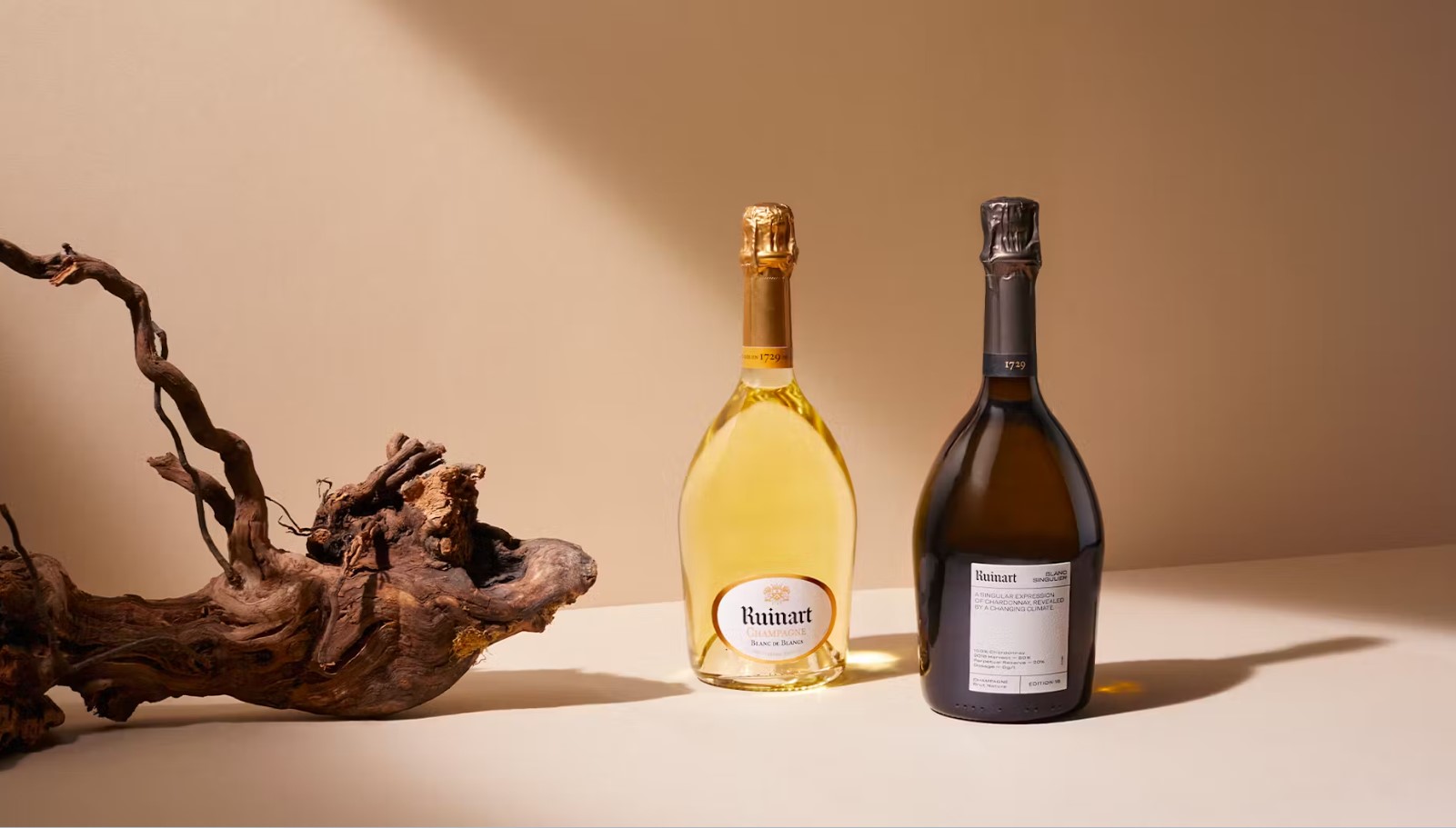
Photo credit: Ruinart Blanc Singulier
Ruinart holds the distinct honor of being the oldest champagne house, established in 1729. There’s something truly magical about sipping a glass of Ruinart, knowing that it was founded nearly three centuries ago. What’s fascinating is how much of this legacy is tied to one man: Dom Thierry Ruinart, a Benedictine monk whose vision laid the foundation for what champagne has become today.
When you visit Ruinart, located in the city of Reims, you can feel the history. You might even get to tour their incredible chalk cellars (or “crayères“), which are so unique they’ve been designated a UNESCO World Heritage site. These cellars, dug deep into the chalky earth of Champagne, provide the perfect conditions for aging their exquisite wines. But let’s talk about the which Ruinart wines to try:
- Ruinart Blanc de Blancs: One of Ruinart’s most beloved offerings is the Blanc de Blancs, which is 100% Chardonnay. If you’re someone who loves a champagne that’s crisp, fresh, and elegant, this is a must-try. The grapes mainly come from the Côte des Blancs and Montagne de Reims, areas known for producing top-quality Chardonnay. What stands out about the Blanc de Blancs is its vibrant acidity and bright, citrusy notes. On the palate, you’ll get a beautiful balance of lemon, green apple, and white flowers, with a subtle minerality that reflects the chalky soils where the grapes are grown. When I first tried this champagne, it was at a seafood dinner in Paris, and the pairing was divine. Blanc de Blancs is the perfect match for oysters, scallops, and any light seafood dish. Its brightness cuts through the richness of the food, making it an incredibly refreshing companion.
- Ruinart Rosé: If you’re in the mood for something a bit more adventurous, Ruinart Rosé is another excellent choice. Made from a blend of Chardonnay and Pinot Noir, this rosé champagne has a rich, fruity character, with notes of raspberry, cherry, and a hint of spice. What I love about this rosé is its versatility. It’s perfect for an aperitif, but it also holds up well with a variety of foods, from roasted chicken to even a juicy steak. The color is striking—a deep coral pink that adds a touch of elegance to any occasion. For me, Rosé Champagne is always a bit of a showstopper, and Ruinart’s version doesn’t disappoint. It’s luxurious without being too heavy, making it a great option whether you’re celebrating a special event or just enjoying a quiet evening at home.
Ruinart embraced eco-friendly practices, including reducing the use of chemicals in the vineyard and introducing Second Skin packaging, a fully recyclable paper casing that reduces waste. Their latest cuvée, which reflects climate change, shows that Ruinart isn’t just resting on its historical laurels—they’re thinking about the future of champagne production, which is pretty exciting if you ask me.
Moët & Chandon
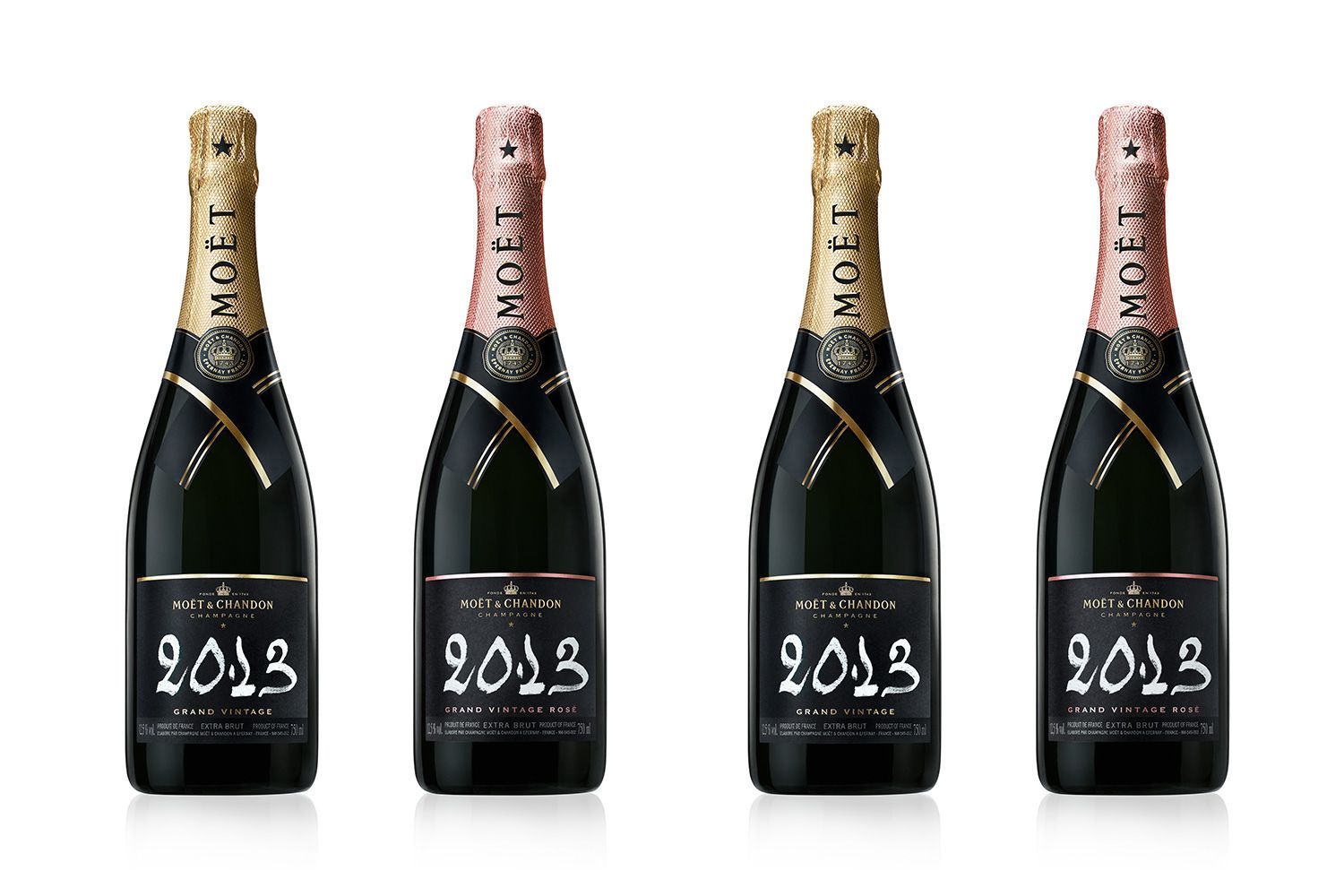
Photo credit: Moët & Chandon Grand Vintage
Now let’s move on to Moët & Chandon, another iconic name in the world of champagne. Founded in 1743 by Claude Moët, this house has grown into one of the largest and most recognized champagne producers globally. Whether you’re celebrating New Year’s Eve, toasting at a wedding, or popping a bottle for a casual get-together, chances are you’ve seen or tasted Moët & Chandon. One of the things we appreciate about Moët & Chandon is that, despite its size and popularity, it consistently delivers high-quality champagne. Their range includes everything from accessible non-vintage options to the prestigious Dom Pérignon, which is one of the most sought-after vintage champagnes in the world.
- Moët & Chandon Brut Impérial: Let’s start with the house’s flagship non-vintage champagne, Moët & Chandon Brut Impérial. This is probably the champagne you’ve seen in movies or at fancy parties—it’s widely available, and for good reason. The Brut Impérial is a classic blend of Pinot Noir, Pinot Meunier, and Chardonnay, which gives it a balanced, approachable flavor profile. On the nose, you’ll get aromas of green apple, citrus, and white flowers, with a hint of brioche that comes from the aging process. The palate is equally inviting, with bright acidity, a touch of stone fruit, and a smooth, creamy finish. What we love about Brut Impérial is its versatility. It pairs beautifully with appetizers like smoked salmon, bruschetta, or even sushi, but it’s also fantastic on its own as an aperitif. If you’re just starting to explore champagne or want a reliable bottle that won’t break the bank, you really can’t go wrong with Moët & Chandon Brut Impérial. It’s a crowd-pleaser and a safe bet for any occasion.
- Moët & Chandon Grand Vintage: Another fantastic option from Moët & Chandon is their Grand Vintage series. These are also vintage champagnes, meaning they’re made from grapes harvested in a single year, but they tend to be a bit more affordable than Dom Pérignon. Each Grand Vintage is unique, reflecting the characteristics of that particular year. We recently enjoyed the Moët & Chandon Grand Vintage 2013, and it was stunning. This particular vintage has a rich, full-bodied profile, with notes of ripe stone fruit, toasted nuts, and a hint of vanilla from the extended aging process. It’s a bit more complex than the Brut Impérial, making it a great choice for pairing with food. We found it paired beautifully with truffle risotto and roasted chicken. You can also find Moët & Chandon Grand Vintage Rosé.
Like Ruinart, Moët & Chandon is also taking steps towards more sustainable practices. They’ve made significant efforts to reduce their environmental impact, including reducing water usage, embracing organic farming practices in some of their vineyards, and investing in renewable energy.
Dom Pérignon
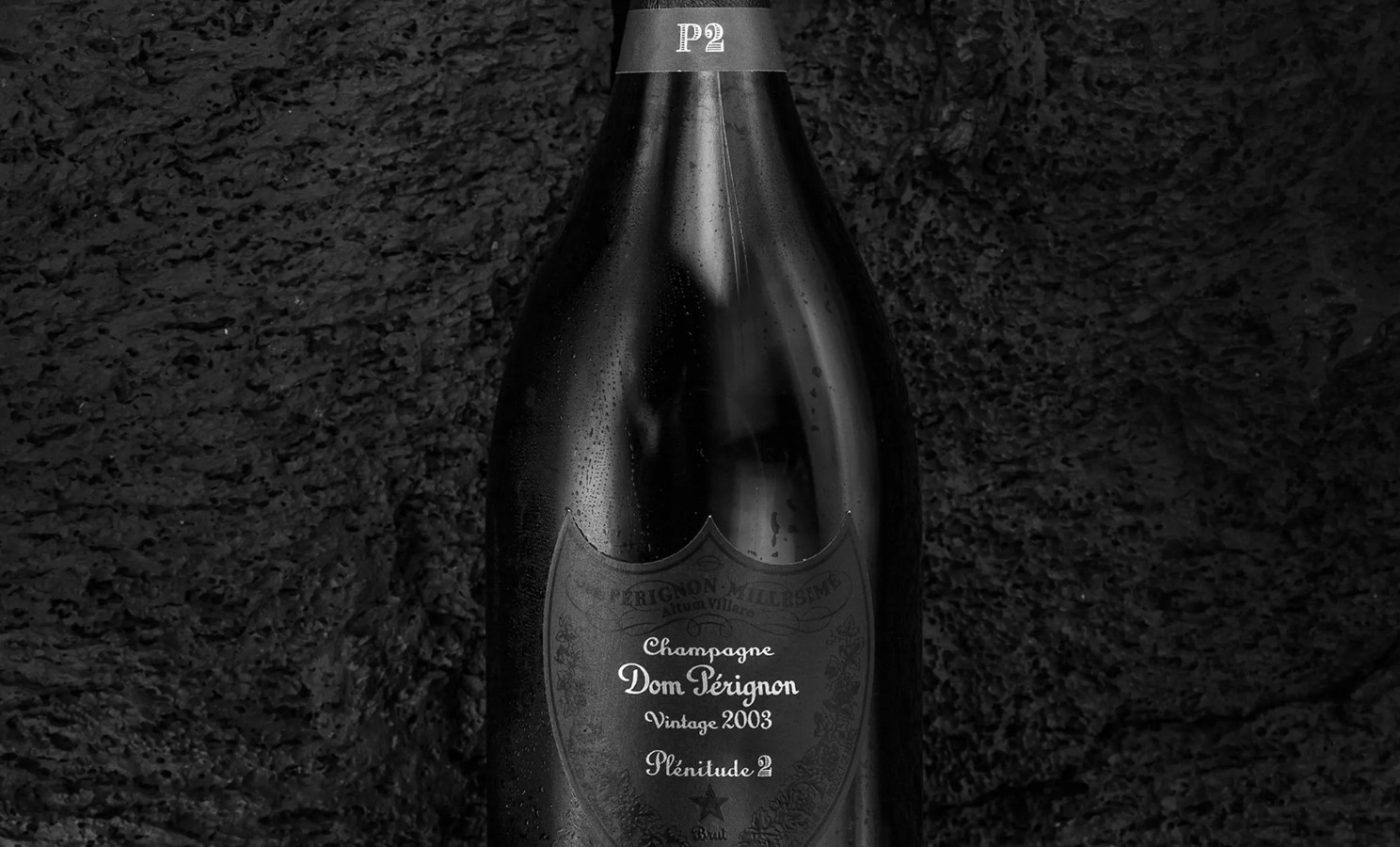
Photo credit: Dom Pérignon P2 (Plénitude 2)
Of course, we can’t talk about Moët & Chandon without mentioning Dom Pérignon, their prestigious vintage champagne. Named after the famous Benedictine monk who is often credited with “inventing” champagne (though that’s a bit of a myth). Although Dom Pérignon did not invent sparkling wine, he did revolutionize its production. His innovations, especially in blending grapes and improving production techniques, played a significant role in transforming what was once a basic wine into the prestigious drink we know today. Dom Pérignon is only produced in the best years, using the highest-quality grapes from a single vintage (only 43 vintages released in the past 100 years!). This also means that in years where the harvest isn’t up to their high standards, Dom Pérignon simply won’t produce any champagne.
I had the chance to taste the Dom Pérignon 2010 recently, and it was an experience I won’t forget. On the nose, it’s incredibly complex—ripe pear, toasted almonds, and a touch of smoky minerality. The palate is equally layered, with flavors of lemon zest, honey, and freshly baked bread, balanced by a vibrant acidity that promises it will age beautifully for years to come. Dom Pérignon isn’t cheap, but if you’re looking for a champagne to mark a special occasion, it’s worth the splurge. This is the kind of bottle you want to savor, preferably with good company and maybe even some foie gras or lobster. Now that we’ve established how incredible Dom Pérignon is, let’s talk about some of the bottles you should try, depending on what kind of experience you’re looking for.
- Dom Pérignon 2010: This is the one I’ve already raved about, and for good reason. The 2010 vintage is a testament to Dom Pérignon’s skill, especially considering the challenges that year brought for grape growers in the Champagne region. With part of the harvest lost to extreme weather and botrytis mold, it’s remarkable that they were able to produce a wine of such depth and complexity.
- Dom Pérignon 2008: Widely considered one of the best Dom Pérignon vintages in recent years, 2008 is all about precision and balance. The acidity is more pronounced in this vintage, making it incredibly fresh and vibrant. If you prefer a champagne that’s a little more structured and crisp, this is the one for you. It pairs beautifully with shellfish, particularly oysters or prawns.
- Dom Pérignon Rosé 2006: If you’re a fan of rosé champagne, then the Dom Pérignon Rosé 2006 is a must-try. Made with a higher proportion of Pinot Noir than the traditional Dom Pérignon, this rosé is rich and full-bodied, with flavors of wild strawberry, spices, and a hint of smoke. It’s a bold champagne that stands up to heartier dishes, making it perfect for pairing with a rack of lamb or even a duck breast.
- Dom Pérignon P2 (Plénitude 2): If you’re looking to take your Dom Pérignon experience to the next level, check out the P2 series. These are bottles that have been aged longer—up to 15 years in some cases—giving them even more depth and complexity. The P2 2000, for instance, is richer and more intense than the standard release, with notes of dried fruit, truffle, and roasted nuts.
Veuve Clicquot
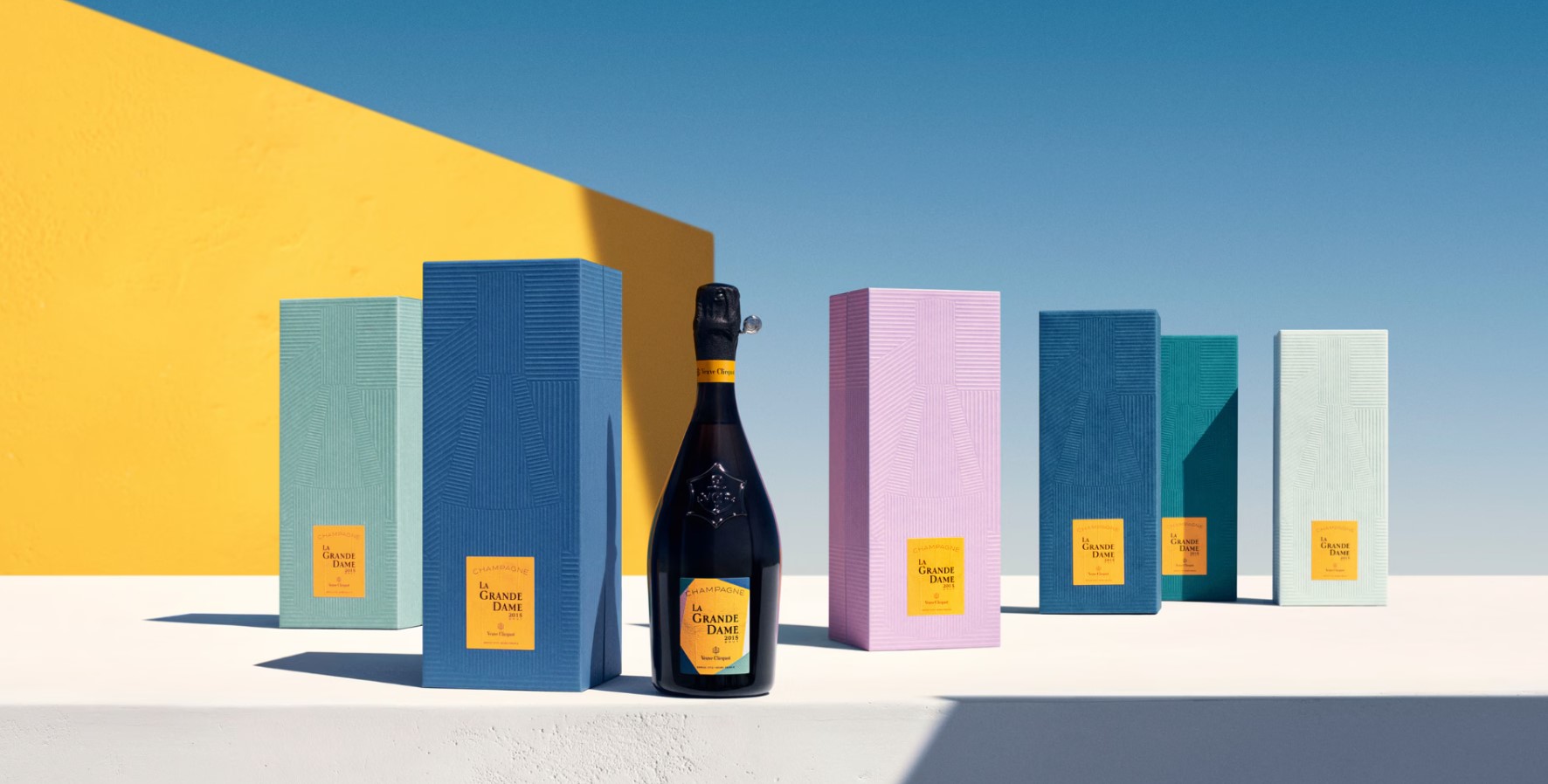
Photo credit: Veuve Clicquot La Grande Dame
One place that really stands out to most Champagne lovers is Reims, home to the legendary Veuve Clicquot. If you haven’t heard of Veuve Clicquot, well, you’re missing out on one of the most iconic champagne houses in the world. And if you have, then you probably know about that striking yellow label, which is practically synonymous with celebration and luxury.
I remember my first encounter with Veuve Clicquot—honestly, it was more out of curiosity than anything else. I had seen the signature yellow label time and time again on the shelves and, admittedly, in many Instagram posts from my fellow travelers and wine lovers. It seemed like every celebration, whether a wedding or a New Year’s Eve toast, featured a bottle of Veuve. So, naturally, I had to see for myself what all the hype was about. Plus, I think part of what draws me to this champagne, and the house of Veuve Clicquot in general, is the story behind it.
It all goes back to Barbe-Nicole Ponsardin, better known as Madame Clicquot. Now, Madame Clicquot wasn’t just any widow running a champagne house. She was a trailblazer, someone who took a family business and turned it into a global phenomenon. We’re talking about the early 19th century, a time when women didn’t run businesses, let alone one in such a male-dominated industry like wine. Yet, here was Madame Clicquot, not just holding her own but innovating and revolutionizing the champagne world.
One of the coolest things I learned was about the riddling table. For those unfamiliar, it’s a technique that Madame Clicquot herself developed to clarify champagne. Before this, champagne had a cloudy appearance due to yeast sediment left in the bottle. By figuring out how to efficiently remove these deposits, Madame Clicquot helped create the clear, crisp champagne we all enjoy today. Pretty impressive, right? I love this story because it shows that Veuve Clicquot’s success wasn’t handed to them—it was earned through hard work, innovation, and a little bit of risk-taking. And if you ask me, that’s what gives the brand its heart and soul.
If you’re ever in the Champagne region, you absolutely cannot miss visiting the Veuve Clicquot in Reims. The cellars are like a champagne lover’s paradise, with miles of tunnels carved into chalk that date back centuries. You’ll learn some fascinating facts during the tour. For example, did you know that Veuve Clicquot only uses the first pressing of the grapes, known as the cuvée? This ensures that only the purest juice makes it into the champagne. When it comes to wine, here are a few of my favorite Veuve lables:
- Veuve Clicquot Yellow Label: Without a doubt, the brand’s most recognizable bottle. It’s a non-vintage Brut champagne, which means it’s made from a blend of several harvests, offering consistency and elegance. It uncovers bright citrus notes with hints of apple and brioche. It has this rich, full-bodied mouthfeel, and it’s the kind of champagne you can pair with just about anything. Enjoy it with oysters, salmon, or sushi.
- La Grande Dame: Named in honor of Madame Clicquot herself. Now, this is vintage champagne, and you can really taste the difference. Unlike the non-vintage Yellow Label, La Grande Dame is made from a single harvest, and it reflects the best that year has to offer. It’s incredibly elegant, with delicate floral and mineral notes. It’s the kind of bottle you bring out for special occasions or when you want to impress your friends who think they know their champagne. For pairing, I’d recommend something equally luxurious, like lobster or foie gras.
- Veuve Clicquot Rosé: With its bold pink color and vibrant berry flavors, it’s the perfect choice for a summer day. Veuve Clicquot’s Rosé is bold, fruity, and just a little bit rebellious. It’s like the fun cousin of the Yellow Label, and it’s perfect for anyone who wants to mix things up a bit.
Bollinger
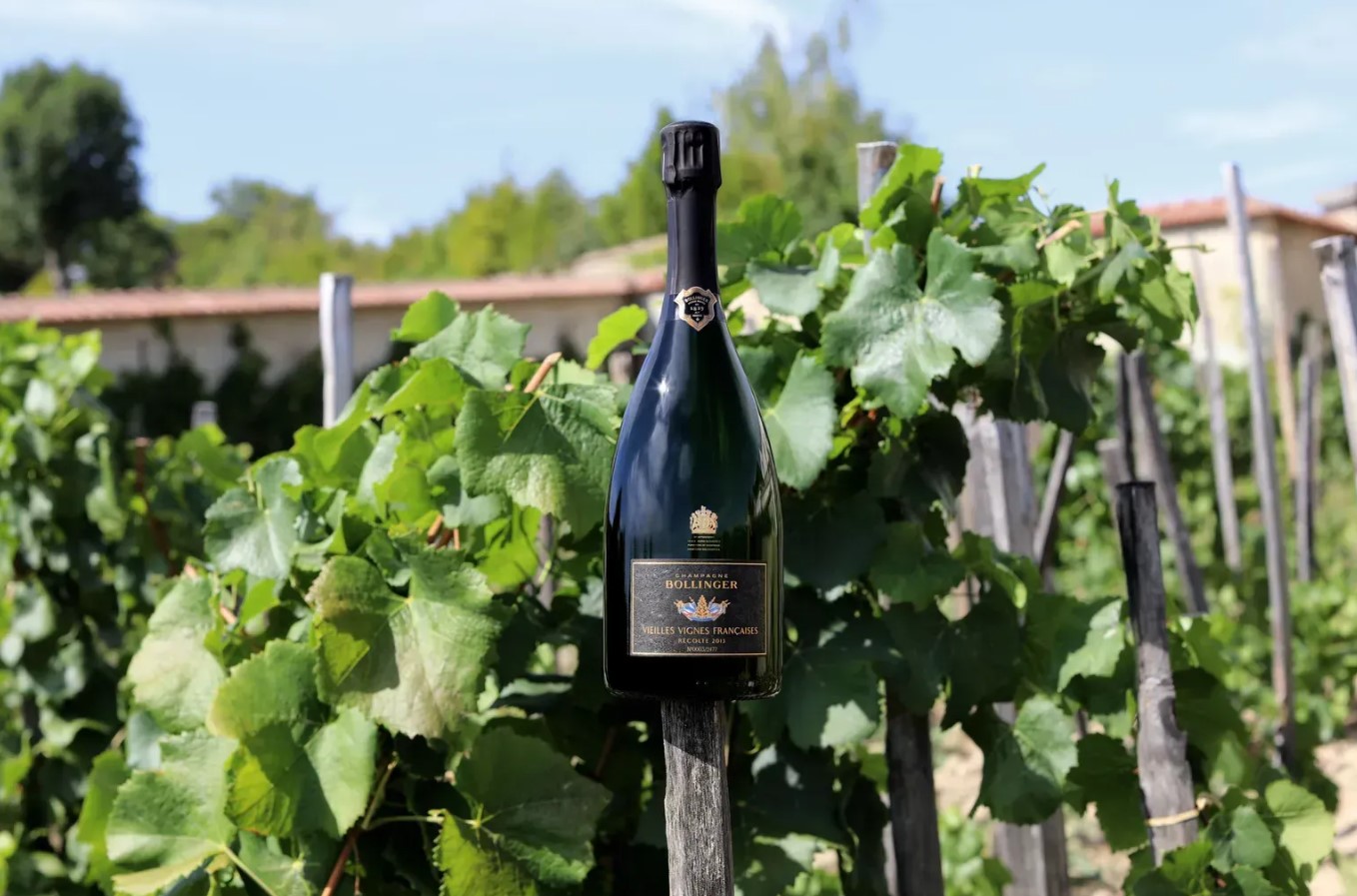
Photo credit: Vieilles Vignes Françaises
Bollinger is one of those champagnes that embodies both tradition and refinement, with a bit of intrigue thrown in. Founded in 1829, Bollinger has become synonymous with sophistication and complexity. But what made this house stand out, beyond its excellent champagne, was the leadership of Lilly Bollinger, who took over after World War II. She wasn’t just content to maintain the status quo, Lilly took Bollinger’s reputation global, traveling the world to market their champagnes. She once famously quipped:
“I drink champagne when I’m happy and when I’m sad. Sometimes I drink it when I’m alone. When I have company I consider it obligatory. I trifle with it if I’m not hungry and drink it when I am. Otherwise, I never touch it — unless I’m thirsty.”
What sets Bollinger apart from other champagnes is their devotion to Pinot Noir. Over 60% of their vineyards are dedicated to this particular grape, and it shows in the structure and depth of their wines. Pinot Noir is a tricky grape to grow, demanding attention and care, but when done right, it adds a remarkable finesse to the wine.
Also, one of the unique things about Bollinger is their commitment to aging their reserve wines in magnums. This isn’t standard practice in the Champagne region, but Bollinger has been doing it since 1890, and it’s become a hallmark of their style. By keeping reserve wines in magnums under cork (as opposed to stainless steel vats), they’re able to maintain a remarkable level of consistency across their non-vintage blends. Time plays a huge role in Bollinger’s winemaking philosophy. While most champagne houses age their wines on the lees for the required minimum, Bollinger takes it much further. Their champagnes are left to rest for twice or even three times as long, allowing the wine to develop those signature rich, toasty notes that we all know and love. When it comes to Bollinger, patience is truly a virtue.
If you ever find yourself in Champagne, France, a visit to Bollinger is an absolute must. Located in the charming village of Aÿ, the Bollinger estate is the place where you can truly feel the weight of its 200-year history as you explore the cellars. Speaking of the cellars, Bollinger has one of the most impressive collections of reserve wines, including magnums that date back decades. In 2010, they even discovered a hidden cellar with bottles dating back to 1830!
During the tour, you’ll also get to see their cooper’s workshop, where they continue the age-old tradition of making and maintaining their oak barrels. In fact, Bollinger is one of the last houses in Champagne to vinify some of their wines in oak, which adds that beautiful, creamy texture to the final product. If you’re wondering which Bollinger bottles are worth adding to your collection or tasting, here are our top three picks:
- Special Cuvée: This is your go-to bottle for any occasion. It’s classic Bollinger—complex, rich, and endlessly enjoyable. It’s made from a blend of 60% Pinot Noir, 25% Chardonnay, and 15% Meunier. Over 85% of the blend are Grand and Premier Cru grapes, with reserve wines that have been aged in magnums for as long as 15 years. This gives the champagne its power, body, longevity, and complexity, with flavors of brioche, apple, pear, spices, and a touch of honey that comes from the aging process. Taste-wise, it’s a beautiful balance of structure and liveliness, with velvet-like bubbles and a long finish.
- La Grande Année 2008: This is a vintage champagne, only produced in the best years, and it offers a completely different level of complexity. Made from 71% Pinot Noir and 29% Chardonnay, La Grande Année is aged much longer than your typical champagne, which allows the flavors to develop beautifully. The 2008 vintage, in particular, is a gem. It’s rich and opulent, with flavors of marzipan, stewed apricots, and honey. The citrus and peach notes give it a refreshing lift, while the bubbles are fine and persistent. If you’re looking for a wine that can stand up to food, this is it. If you’re feeling indulgent, pairing it with truffle risotto would be divine.
- Bollinger R.D. 2008: If you’ve heard of Bollinger, you’ve probably heard of R.D.—short for “Recently Disgorged.” This wine is unique because it’s aged for an exceptionally long time on its lees (the leftover yeast from fermentation), and only released after it’s been recently disgorged, meaning the yeast sediment has been removed. This technique brings out the wine’s freshness and vibrancy while keeping the incredible depth of flavors developed during the long aging process. The R.D. 2008 is something really special. Made from 71% Pinot Noir and 29% Chardonnay, it’s full of rich, complex flavors like hazelnut, citrus, and fresh plum. The wine has an extraordinary balance between freshness and complexity. Pair it with something equally decadent—scallops with hazelnut butter, perhaps?
- Vieilles Vignes Françaises 2013: Now, for the pièce de résistance: the Vieilles Vignes Françaises 2013. This champagne is in a league of its own. Made from two small parcels of ungrafted Pinot Noir vines in Aÿ, this cuvée is one of the rarest and most exclusive champagnes in the world. The vines are farmed using traditional methods—by hand and with the help of a horse (yes, you read that right!). This wine is a time capsule, offering a glimpse into what champagne might have tasted like before the phylloxera crisis that devastated most European vineyards in the late 19th century. The vines have never been grafted onto American rootstock (which was necessary to combat phylloxera), so this champagne offers a truly unique taste that few people in the world get to experience. Only a small number of bottles are produced each year, and they are aged for at least five years before being released. What can you expect from this legendary wine? Imagine a complex, powerful vintage champagne that’s as rare as it is remarkable. It’s a Blanc de Noirs, meaning it’s made entirely from Pinot Noir, and it bursts with flavors of ripe red fruits, fresh hazelnuts, and a subtle salinity that gives it a fresh, almost maritime quality. The finish is incredibly long, with notes of marzipan and dried apricots lingering on your palate. If you ever get the chance to try Vieilles Vignes Françaises, don’t pass it up. It’s the kind of champagne you savor slowly, with good company, or maybe even alone in a quiet moment of reflection—it’s that special.
And let’s not forget that Bollinger holds a Royal Warrant, which it’s had since 1884, marking it as the official champagne supplier to the British royal family. And if that weren’t enough, Bollinger also holds the distinction of being 007’s go-to champagne in the James Bond films.
Louis Roederer
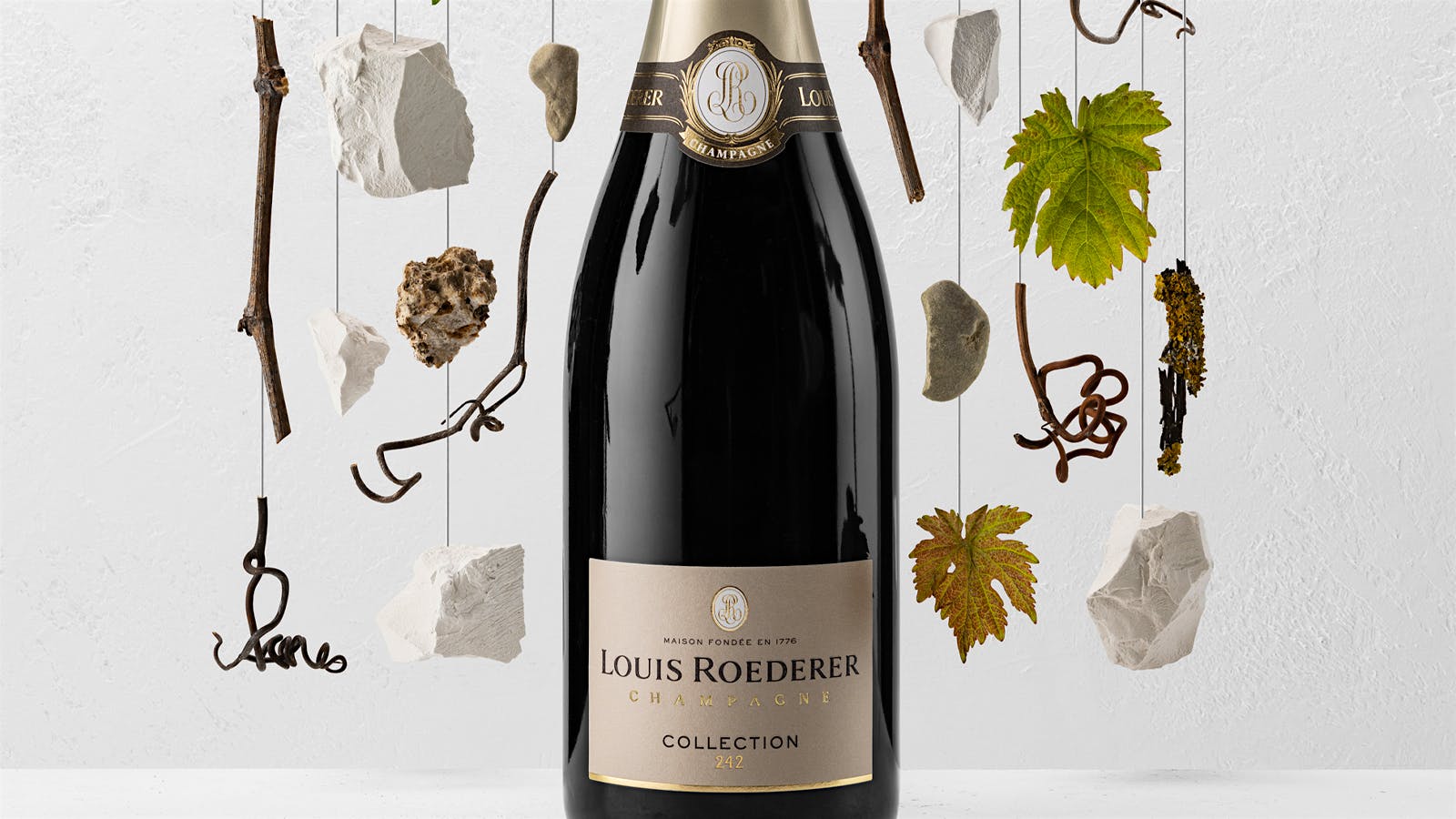
Photo credit: Louis Roederer Collection 245
I’ve always found myself fascinated by the artistry and heritage behind a bottle of champagne, and one name that never fails to captivate me is Louis Roederer. Roederer represents a legacy steeped in history, innovation, and dedication. Founded in 1776, Louis Roederer is one of the few family-owned Champagne houses left in the game, now run by Frédéric Rouzaud, a direct descendant of the founder. The fact that they’ve kept things in the family over the centuries tells you something about their commitment to tradition and excellence. They control nearly 600 acres of prime Champagne real estate, which allows them to oversee the quality of their grapes from vine to bottle.
Pus, tthey’ve been moving towards organic and sustainable viticulture long before it became trendy. As of 2021, half of their vineyards were certified organic, and their long-term goal is to transition even more toward greener farming practices. So, if you’re going to splurge on a bottle (or three), Roederer is a brand you can feel good about supporting, and that’s always a plus in my book.
There’s a reason why Roederer is considered one of the world’s most admired champagne brands. First and foremost, their philosophy has always been centered around the vineyard itself. Unlike many other houses that source their grapes from different growers, Roederer takes a plot-by-plot approach. Each parcel of land they own is treated as its own unique entity, which allows them to tailor their cultivation methods and really focus on producing the highest quality grapes.
Pinot Noir, Chardonnay, and Pinot Meunier make up the backbone of their wines, but it’s how Roederer handles these grapes that really sets them apart. They’ve mastered the art of blending, allowing each vintage to highlight the characteristics of the terroir and the specific year it was harvested. And then, of course, there’s their perpetual reserve system, which blends wines from multiple years to create the perfect harmony in each bottle. This method means that even non-vintage champagnes from Roederer maintain an exceptional level of consistency and complexity. The balance, freshness, and depth that comes through in every sip? That’s no accident. It’s the result of hundreds of years of perfecting their craft.
Now, onto the fun part—what bottles should you actually try? These three picks from Louis Roederer’s collection are worth every penny.
- Brut Premier: If you’re looking for an entry point into the world of Louis Roederer, you can’t go wrong with Brut Premier. A testament to Roederer’s commitment to quality, even in their more “accessible” champagnes. The blend of multiple vintages gives it a rounded, consistent flavor profile—think fresh fruit, a touch of toastiness, and a lingering, clean finish. I’ve always found it pairs wonderfully with soft cheeses or light appetizers.
- Cristal: Created in 1876 for the Russian Tsar Alexander II, this bottle is legendary. The Tsar wanted a champagne so special that it was served in a unique clear glass bottle with a flat bottom. Why? To prevent assassination attempts—he was a bit paranoid, and rightly so. Over time, it’s become one of the most prestigious champagnes you can get your hands on. It’s both powerful and delicate, a champagne that balances subtlety with precision. The way it combines fruity aromas with a strong mineral backbone is unmatched, and it’s no surprise that it’s aged for six years in Roederer’s cellars before it even hits the shelves. If you’re going to try just one bottle from this house, Cristal is the one to start with. If you’ve never tasted Cristal, the 2014 vintage is an excellent starting point. Pair it with something luxurious, like lobster or caviar, to get the full experience.
- Collection 245: Next up is Collection 245, which, in my opinion, perfectly encapsulates Roederer’s forward-thinking approach to winemaking. Crafted from the 2020 harvest, this multi-vintage champagne is an ode to the art of blending. It includes wines from their perpetual reserve, which dates back to 2012. That means you’re tasting not just one year’s worth of work, but a culmination of Roederer’s expertise over time. The 2020 harvest was a standout year for Champagne—dry and continental, with perfectly ripe grapes. You’ll find that Collection 245 is complex yet approachable, offering layers of citrus, yellow fruit, and just a hint of oak. This bottle is perfect for those who appreciate depth but don’t want something too overpowering. It’s great with seafood, especially something like scallops or a rich shellfish bisque.
When I think about Louis Roederer, I think about history, family, and an unwavering commitment to quality. Every bottle from this house tells a story, as they’re constantly innovating, whether that’s through sustainable farming practices or experimenting with new blending techniques.
Champagne Taittinger
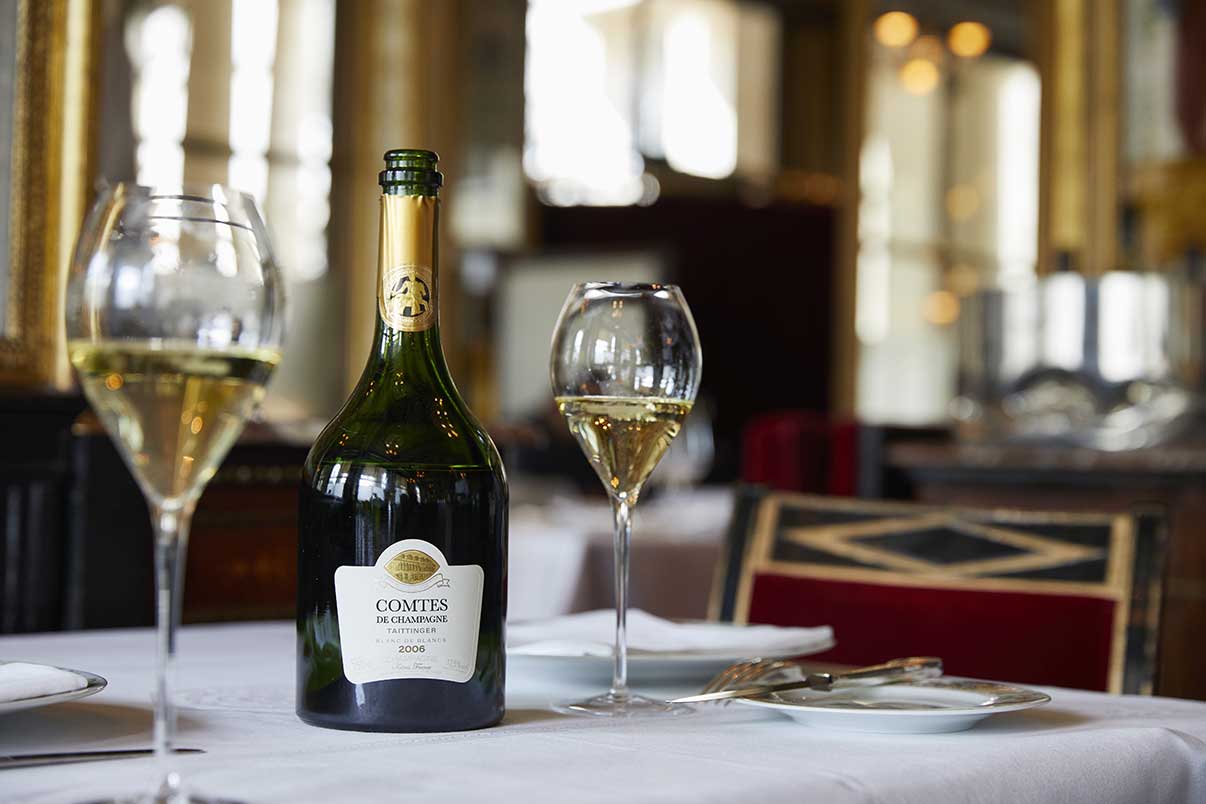
Photo credit: Champagne Taittinger
Taittinger is one of those Champagne houses that has stood the test of time but also managed to grow in both reputation and finesse. It’s been around since 1734—yes, almost 300 years!—and has evolved into one of the most respected Champagne producers globally. Before we dive into my favorite Taittinger bottles you absolutely must try, let’s set the stage. Taittinger is one of the few big Champagne houses still family-run. Pierre Taittinger’s descendants, Clovis and Vitalie Taittinger, now oversee daily operations.
Taittinger owns around 700 acres of prime real estate in the Champagne region, including some Grand Cru vineyards. If you ever find yourself in the Champagne region, do yourself a favor and make an appointment at Taittinger’s headquarters in Reims. Plus, the city of Reims itself is a gem. You can spend the morning visiting the famous Reims Cathedral—where French kings were once crowned—and then pop over to Taittinger for an afternoon of bubbles.
Their cellars are built in ancient Gallo-Roman chalk quarries, some of which date back to the 4th century. As you descend into these cool, stone caverns, you’re literally walking through centuries of winemaking history. Taittinger’s prized cuvée, Comtes de Champagne, is aged right there in those hallowed halls. It’s something special to see how much care and tradition go into each bottle. If you ever get the chance to tour these cellars, we highly recommend it. Now, onto the good stuff—the wines! Here are three Taittinger bottles that really stand out, each for their own reasons.
- Taittinger Brut Réserve: If you’re going to start anywhere, start here. It’s a flagship non-vintage Champagne, and it’s a total crowd-pleaser. What makes it unique is the unusually high proportion of Chardonnay (about 40%) for a non-vintage blend. The result is a Champagne that’s bright, fresh, and balanced, with a mix of brioche, honey, and green apple. It’s elegant but not overly complicated, making it perfect for any occasion. This is a fantastic bottle to bring to a dinner party if you want to introduce people to the finer side of Champagne without breaking the bank. Pair it with seafood, like oysters or shrimp cocktail, and you’re golden.
- Taittinger Comtes de Champagne Blanc de Blancs: This is where things get serious. We’re talking about one of the purest expressions of Chardonnay in Champagne, made exclusively from Grand Cru vineyards. This bottle has a certain ethereal quality to it. It’s aged for nearly a decade in those ancient cellars I mentioned earlier, which gives it a complexity that’s hard to beat. The flavors of white flowers, citrus, and almond dance around a palate, and the finish? Incredibly long and rich. Honestly, this is the kind of Champagne you save for life’s biggest moments—or, if you’re like me, for those evenings when you just want to treat yourself to something extraordinary. Pair it with lobster, or a truffle risotto, and you’ll see why this cuvée has earned such a stellar reputation.
- Taittinger Prestige Rosé: Now, I have to admit, I’ve got a bit of a soft spot for rosé Champagne, and Taittinger’s Prestige Rosé does not disappoint. First of all, the color is this beautiful, shimmering pink, which is thanks to the 15% red Pinot Noir still wine that’s blended in. It’s full of red fruit—strawberries, raspberries, and cherries—with a nice backbone of freshness and acidity.It’s playful yet elegant, making it the perfect bottle for, well, pretty much any occasion. I love serving this rosé with charcuterie boards, especially ones loaded with cured meats and cheeses.
In a world of luxury brands and Champagne houses, Taittinger holds a special place in my heart, and I think it will in yours too. There’s something incredibly authentic about this family-run operation. Despite their global reputation, there’s still a sense of humility and tradition in everything they do.
Pol Roger
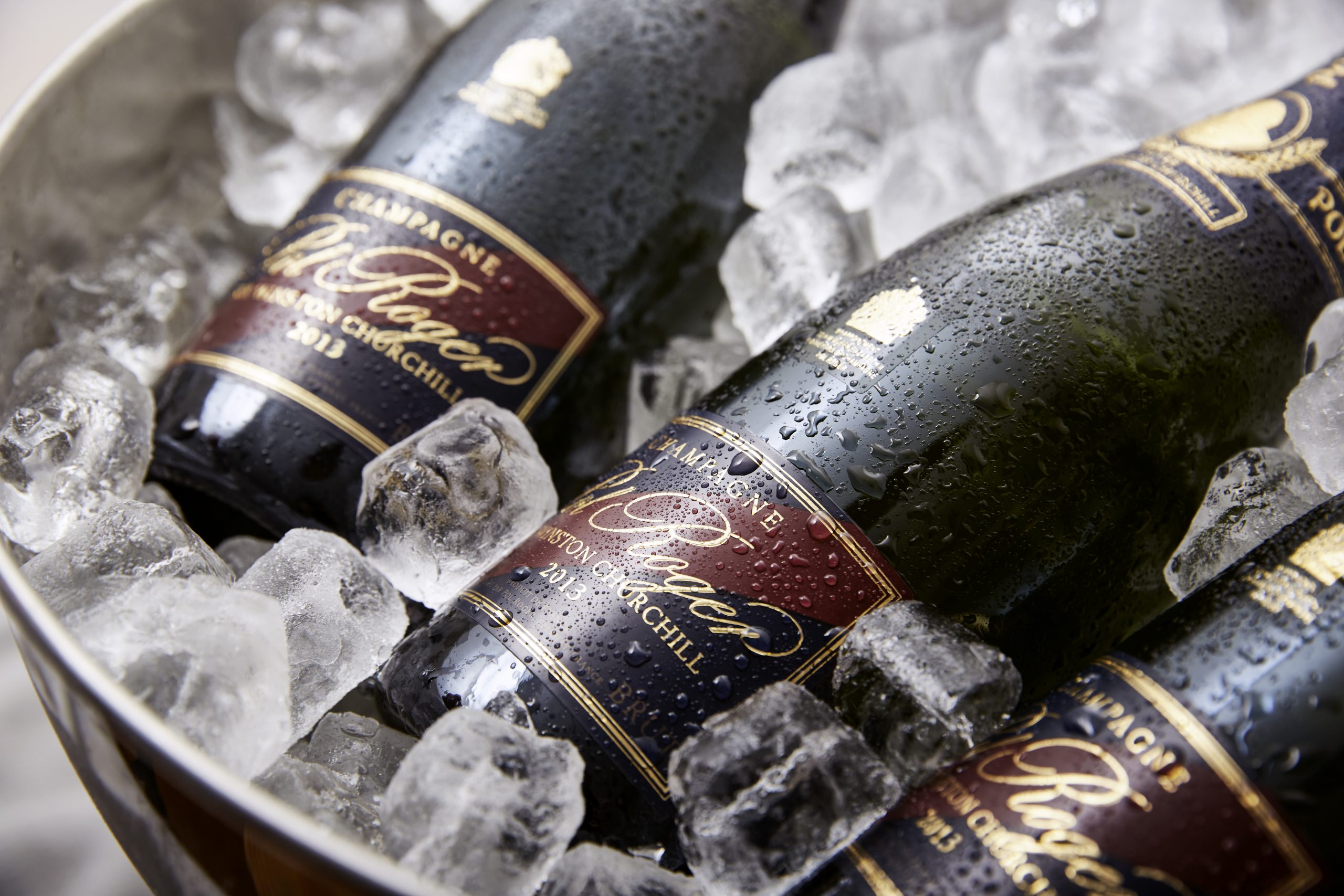
Photo credit: Pol Roger Sir Winston Churchill
Founded in 1849, Pol Roger has always focused on producing top-quality Champagne. The house is situated in Epernay, another renowned Champagne town, and it sources grapes from some of the finest vineyards in the region. This Champagne House has an interesting historical connection, due to its association with Sir Winston Churchill.
The friendship between the Maison Pol Roger and Churchill began in 1945 during a luncheon where the prime minister and Odette Pol-Roger became instant friends. The strong ties between the two families continue to this day; Pol Roger’s Prestige cuvée is named Cuvée Sir Winston Churchill in honor of the man and the characteristics he preferred in champagne: a full-bodied character, robustness, and maturity. Here are some of our favorite bottles:
- Brut Réserve: Often referred to as “gentlemen’s Champagne.” It’s refined, polished, and incredibly well-balanced. Pol Roger tends to favor a blend of all three Champagne grapes—Pinot Noir, Pinot Meunier, and Chardonnay—so you get a lovely mix of richness from the Pinot Noir and freshness from the Chardonnay. It’s got this creamy texture and notes of apple, pear, and a bit of toast. It’s not overly complicated. This is the Champagne I grab when I want something reliable that I know will deliver. If you’re having a casual get-together and want to elevate the mood, this is your bottle. It pairs beautifully with everything from grilled chicken to light pastas, and it’s also great on its own.
- Cuvée Sir Winston Churchill: This is Pol Roger’s top-tier Champagne, and it’s as bold and full-bodied as the man it’s named after. Made predominantly with Pinot Noir, this Champagne has a richness and structure that’s just incredible. It’s got layers of dried fruit, toasted almonds, and a bit of spice, all wrapped up in a smooth, creamy texture. This isn’t a Champagne you casually sip at a party; it’s one you savor, preferably with a rich meal. I’m talking roasted duck, lamb, or even a hearty mushroom risotto.
- Pol Roger Vintage Brut: This is a great middle-ground if you want something a little more special than the non-vintage but don’t want to spring for the Sir Winston Churchill. The Vintage Brut is made from the best grapes of a single year and is aged for about seven years before release. The result is a Champagne with depth and character. It’s got a bit more structure than the Brut Réserve, with flavors of citrus, green apple, and a touch of honey. The bubbles are fine and persistent, giving it a nice, creamy mouthfeel. This is the kind of Champagne you can easily enjoy with a wide variety of foods, from seafood to roasted chicken. This is a great bottle to bring out for a dinner party where you’re serving a full meal. It can handle richer dishes but is still fresh enough to be enjoyed as an aperitif.
Krug
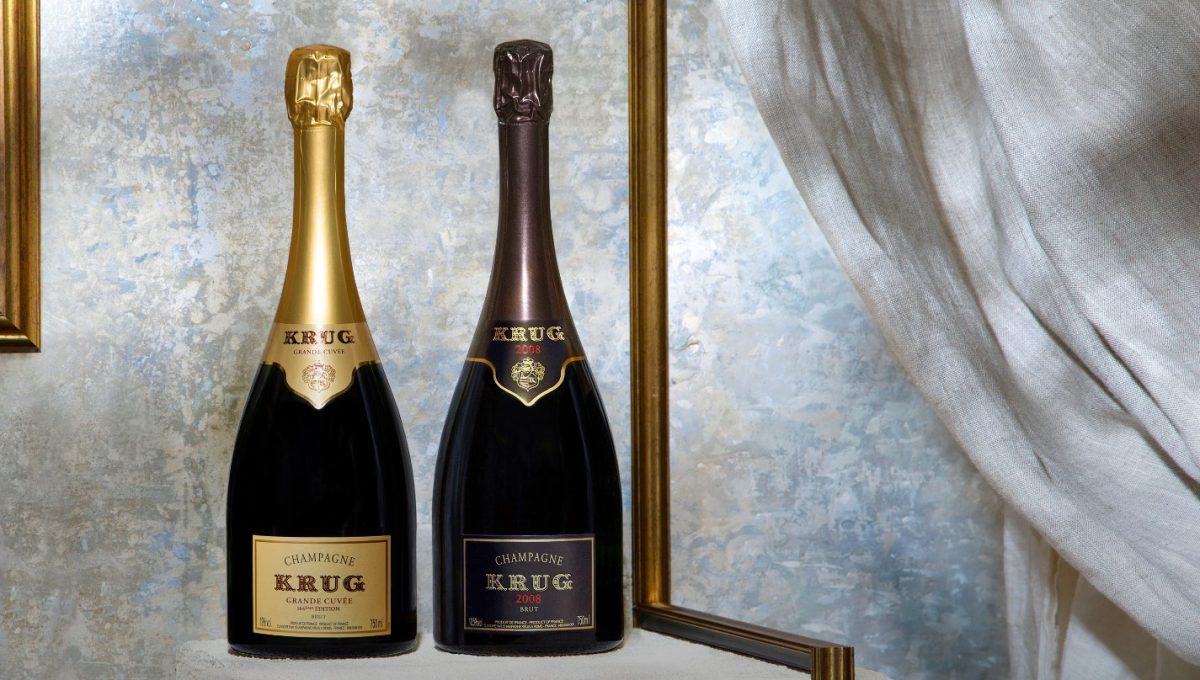
Photo credit: Krug
When it comes to champagne, there’s something about Krug that feels like pure magic. Established in Reims back in 1843 by Joseph Krug, it’s been crafting prestige champagnes every single year, no matter what nature throws its way. Think about that: most champagne houses release their top-tier bottles only in the best years, but Krug? They’ve been delivering year after year for over 180 years. That’s consistency on another level.
Joseph Krug had a vision: create a champagne that could be offered every year, a champagne that didn’t rely on perfect weather or ideal growing conditions. He wanted to craft a champagne that focused on pleasure itself, something that would wow people no matter the season or circumstances. And you know what? He made it. They don’t blend everything right away. Instead, they keep wines from 250 different vineyard plots separate, following the character of each wine over time. Only when the wine has fully revealed itself do they start blending. It’s this meticulous attention to detail that allows Krug to create such exceptional champagnes.
Champagne ages differently depending on the bottle size. Krug is one of the few houses that produces magnums. Magnums of Krug are aged at least one year longer on the lees than the standard 75cl bottles, which gives them even more time to develop those complex, nuanced flavors. The larger format slows down the aging process, so the champagne evolves more gradually.
And it’s not just their winemaking process that’s impressive. Krug is also a bit of a tech innovator. Every bottle of Krug comes with a six-digit Krug iD printed on the label. With that iD, you can dive into the story behind your bottle, from detailed food pairings to even music suggestions tailored to heighten your drinking experience. Yes, music! Who knew pairing a bottle of Krug with a curated playlist could enhance the flavor? It’s that kind of attention to detail that makes this champagne house stand out, not just in the world of sparkling wines, but in the broader world of luxury experiences. Now, if you’re curious about where to start with Krug (and trust me, you should be), here are three bottles you won’t want to miss.
- Krug Grande Cuvée: If there’s one bottle that encapsulates everything Krug is about, it’s the Krug Grande Cuvée. Joseph Krug’s original dream was to craft a champagne that reflected the best of the house every year, and this is it. The 170ème Édition is made from a blend of over 120 wines from at least ten different vintages, which is pretty wild when you think about it. It’s like a symphony in a glass—rich, complex, and layered, with flavors of ripe fruit, citrus, hazelnut, and brioche. You can pair it with so many different foods. There’s a fullness and generosity to the flavor that can hold up to a variety of dishes. It’s no wonder they call this “the most generous expression of champagne.”
- Krug Rosé 26ème Édition: This isn’t your typical rosé champagne. It’s bold, sophisticated, and has layers of flavor that just keep revealing themselves with every sip. The 26ème Édition is made from a blend of different wines, including Pinot Noir, Chardonnay, and Meunier, with a touch of skin-fermented Pinot Noir added for depth. What really sets it apart, though, is the way it combines elegance with spice. You get those classic red fruit notes—think strawberry, raspberry—but there’s also a savory, almost exotic spiciness to it. Pair it with dishes like duck breast, tuna sashimi, or even spicy dishes, and it’s a game-changer. It’s not just a “summer rosé” kind of drink; this is for the foodies who want to push boundaries.
- Krug Vintage 2006: Every Krug Vintage is a “champagne of circumstances,” as they like to say. What that means is that each vintage reflects the unique character of a single year, and the 2006 Vintage is no exception. This bottle is a celebration of what that year in the vineyards gave them—a rich and vibrant year for the grapes. The 2006 is all about richness and warmth. It’s got this deep, honeyed character with layers of citrus, toasted almond, and a hint of spice. The balance between fruit and acidity is spot-on, making it a fantastic bottle to pair with dishes like foie gras, truffle risotto, or even aged cheese. What’s also fascinating is that Krug’s vintages spend over ten years aging in the cellar before they’re even released. Time, as Krug likes to say, is not a constraint for them—it’s their greatest ally.
Why Champagne is Truly Special
First, let’s clarify a common point of confusion: champagne is a sparkling wine, but only sparkling wines produced in the Champagne region of France get to wear that prestigious title. This isn’t just a marketing gimmick – the region’s soil, climate, and traditional production methods are what give champagne its distinctive character.
The méthode champenoise, also known as traditional method, involves a second fermentation in the bottle, creating those signature fine bubbles. This process is labor-intensive, but the results are unmatched in terms of complexity and texture. It’s what sets champagne apart from other sparkling wines like Prosecco (Italy) or Cava (Spain), which use different techniques and grape varieties.
The Key Difference: Non-Vintage vs. Vintage Champagne
One of the most important distinctions to understand is between non-vintage (NV) and vintage champagnes:
- Non-Vintage: These are blended from multiple years of harvest to ensure consistency in flavor. They’re meant for immediate enjoyment, perfect for casual celebrations or dinner pairings.
- Vintage: These champagnes come from a single year’s harvest and are produced only in exceptional years. They tend to be more complex, often with the potential to age for decades, making them ideal for special occasions or as a statement gift.
If you’re new to champagne or looking for an everyday option, start with a well-made non-vintage. For something more sophisticated or celebratory, a vintage bottle is well worth the investment.
Champagne vs. Other Sparkling Wines
It’s important to note the key differences between champagne and other sparkling wines like Prosecco or Cava. Prosecco, for example, is produced using the Charmat method, where the second fermentation happens in a tank rather than in the bottle. This results in larger, less refined bubbles and a lighter, fruitier profile. It’s a great option for casual sipping but doesn’t quite reach the depth or complexity of champagne.
Cava, on the other hand, also uses the traditional method but with different grapes (like Macabeo and Parellada). While Cava can offer good value and complexity, it still lacks the richness and prestige of champagne.
How to Choose the Right Champagne
So, how do you navigate the wide world of champagne? It really comes down to your personal taste and the occasion. Here’s a quick guide:
- Non-Vintage Brut: The most common style of champagne – dry, balanced, and versatile. Ideal for almost any event, from dinner parties to casual celebrations.
- Blanc de Blancs: Made exclusively from Chardonnay grapes, offering a light, crisp, and elegant profile. Perfect for those who enjoy a fresher, more citrus-forward champagne.
- Rosé Champagne: For those who prefer a richer, fruitier style. Rosé champagne often has more body and depth, thanks to the addition of red wine during production.
- Vintage Champagne: Complex, layered, and often with the ability to age. Vintage champagnes are a great choice for special occasions or for collectors who enjoy cellaring bottles.
A Closer Look at Champagne Production
Let’s take a quick peek into what makes champagne so unique in the winemaking world. Everything starts with the three main grape varieties: Chardonnay (for elegance and freshness), Pinot Noir (for structure and richness), and Pinot Meunier (for fruitiness and softness). The cooler climate of the Champagne region ensures that these grapes retain their acidity, which is crucial for a well-balanced sparkling wine.
After the first fermentation, the wine is bottled and a small amount of dosage (sugar and yeast) is added to trigger a second fermentation in the bottle. This is what creates the bubbles. The wine is then aged on the lees (the dead yeast cells), which adds complexity, nuttiness, and depth to the final product. The longer it’s aged, the more developed the flavors become.
Final Thoughts
If you’re lucky enough to visit the Champagne region in France, do it. It’s beautiful, and getting to taste champagne right where it’s made is a next-level experience. Plus, you can explore all those legendary Champagne Houses and maybe even discover a new favorite that you can brag about back home.
If you’re looking for the best wine tours in Champagne or champagne tours in Epernay, we’ve got you covered with an in-depth guide to help you find the perfect experience. Planning a trip to the Champagne region? Be sure to read our article covering a Champagne getaway and discover the best hotels and wineries in the region for insider tips on where to stay and sip. And if Epernay is on your itinerary, don’t miss our recommendations on the best places to stay in Epernay to make your visit unforgettable.
Cheers to discovering your next great bottle of champagne!

